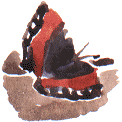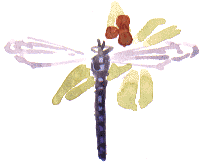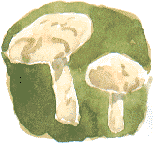Nature Diary
Rocks
History
Gallery
Home Page
 A RED ADMIRAL is attracted to the compost bucket on the patio. Perhaps it is just a place to sunbathe, more likely it is attracted by the over-ripe fruit in the bucket. Like the Painted Lady yesterday, and the Small Copper the day before, this is a first-time-this-year butterfly for me. When I sketched the Admiral later from memory I painted its red stripe in the wrong alignment.
A RED ADMIRAL is attracted to the compost bucket on the patio. Perhaps it is just a place to sunbathe, more likely it is attracted by the over-ripe fruit in the bucket. Like the Painted Lady yesterday, and the Small Copper the day before, this is a first-time-this-year butterfly for me. When I sketched the Admiral later from memory I painted its red stripe in the wrong alignment.
 A black, blue-marked dragonfly comes to rest on the Honeysuckle. It looks like a male Common Hawker, Aeshna juncea, a smaller relative of the Large Aeshna which also patrols the garden on this hot sunny day.
A black, blue-marked dragonfly comes to rest on the Honeysuckle. It looks like a male Common Hawker, Aeshna juncea, a smaller relative of the Large Aeshna which also patrols the garden on this hot sunny day.
The Large Aeshna reminds me of a military helicopter as it negotiates the shrub bed, banking around the Buddlehias on the look-out for prey. I catch sight of a shadow sweeping across the patio and look up expecting to see a bird, but it is the Aeshna on patrol
In the afternoon a Kestrel circles above the garden, not that much higher than the roof-tops. As it continues to circle and gain height over the meadow we notice that it has a companion, circling as high again above it. The House Martins occasionally swoop at them.
 While working in the studio I hear what sounds like fifty House Sparrows, chirruping in the hedge by the shed. The noise level is what you'd expect if you were visiting a large avairy. I'm painting dinosaurs so, inevitably, I speculate on whether they were as vocal and sociable as their supposed descendants, the birds. Pulitzer prize-winning naturalist Edwin Way Teale once described house sparrows as 'those commonplace but surprising birds that possess twice as many neckbones as a giraffe'.
While working in the studio I hear what sounds like fifty House Sparrows, chirruping in the hedge by the shed. The noise level is what you'd expect if you were visiting a large avairy. I'm painting dinosaurs so, inevitably, I speculate on whether they were as vocal and sociable as their supposed descendants, the birds. Pulitzer prize-winning naturalist Edwin Way Teale once described house sparrows as 'those commonplace but surprising birds that possess twice as many neckbones as a giraffe'.
Edwin Way Teale was born one hundred years ago in Joliet, Illinois, but his father came from this part of the Calder Valley, Yorkshire. He was born in Ossett in 1865 and, until emigrating to the United States, lived a few miles further up the valley at Ravensthorpe.
' . . . Ravensthorpe. This was the place from which my father had come.' writes Teale in Springtime in Britain 'Glad I was that he had come.'
 On our walk down the lane I try to take another look at the russet fungus I noticed yesterday. It has gone now, but another, more numerous, fungus is still growing nearby on the grass verge. This light brown fungus is the equivalent of the 'little brown bird' that mystyfies beginners to birdwatching. I take a closer look at this, to me, non-descript species. Perhaps one day I'll identify it.
On our walk down the lane I try to take another look at the russet fungus I noticed yesterday. It has gone now, but another, more numerous, fungus is still growing nearby on the grass verge. This light brown fungus is the equivalent of the 'little brown bird' that mystyfies beginners to birdwatching. I take a closer look at this, to me, non-descript species. Perhaps one day I'll identify it.
It takes a while to get familiar with any wild species. Having noticed the Fairy Ring Champignon in a conspicuous circle on a lawn the other day I now notice it growing in smaller groups by the towpath.
Richard Bell,
wildlife illustrator
E-mail; 'richard@daelnet.co.uk'
|
 A RED ADMIRAL is attracted to the compost bucket on the patio. Perhaps it is just a place to sunbathe, more likely it is attracted by the over-ripe fruit in the bucket. Like the Painted Lady yesterday, and the Small Copper the day before, this is a first-time-this-year butterfly for me. When I sketched the Admiral later from memory I painted its red stripe in the wrong alignment.
A RED ADMIRAL is attracted to the compost bucket on the patio. Perhaps it is just a place to sunbathe, more likely it is attracted by the over-ripe fruit in the bucket. Like the Painted Lady yesterday, and the Small Copper the day before, this is a first-time-this-year butterfly for me. When I sketched the Admiral later from memory I painted its red stripe in the wrong alignment. A black, blue-marked dragonfly comes to rest on the Honeysuckle. It looks like a male Common Hawker, Aeshna juncea, a smaller relative of the Large Aeshna which also patrols the garden on this hot sunny day.
A black, blue-marked dragonfly comes to rest on the Honeysuckle. It looks like a male Common Hawker, Aeshna juncea, a smaller relative of the Large Aeshna which also patrols the garden on this hot sunny day. While working in the studio I hear what sounds like fifty House Sparrows, chirruping in the hedge by the shed. The noise level is what you'd expect if you were visiting a large avairy. I'm painting dinosaurs so, inevitably, I speculate on whether they were as vocal and sociable as their supposed descendants, the birds. Pulitzer prize-winning naturalist Edwin Way Teale once described house sparrows as 'those commonplace but surprising birds that possess twice as many neckbones as a giraffe'.
While working in the studio I hear what sounds like fifty House Sparrows, chirruping in the hedge by the shed. The noise level is what you'd expect if you were visiting a large avairy. I'm painting dinosaurs so, inevitably, I speculate on whether they were as vocal and sociable as their supposed descendants, the birds. Pulitzer prize-winning naturalist Edwin Way Teale once described house sparrows as 'those commonplace but surprising birds that possess twice as many neckbones as a giraffe'. On our walk down the lane I try to take another look at the russet fungus I noticed yesterday. It has gone now, but another, more numerous, fungus is still growing nearby on the grass verge. This light brown fungus is the equivalent of the 'little brown bird' that mystyfies beginners to birdwatching. I take a closer look at this, to me, non-descript species. Perhaps one day I'll identify it.
On our walk down the lane I try to take another look at the russet fungus I noticed yesterday. It has gone now, but another, more numerous, fungus is still growing nearby on the grass verge. This light brown fungus is the equivalent of the 'little brown bird' that mystyfies beginners to birdwatching. I take a closer look at this, to me, non-descript species. Perhaps one day I'll identify it.